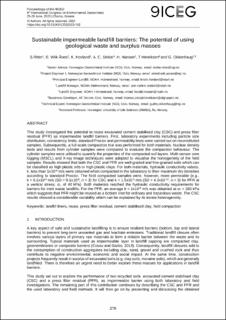| dc.description.abstract | This study investigated the potential to reuse excavated cement stabilised clay (CSC) and press filter residual (PFR) as impermeable landfill barriers. First, laboratory experiments including particle size distribution, consistency limits, standard Proctor and permeability tests were carried out on reconstituted samples. Subsequently, a full-scale compaction trial was performed for both materials. Nuclear density tests and results from cylinder samples were compared to evaluate the compaction behaviour. The cylinder samples were utilised to quantify the properties of the compacted soil layers. Multi-sensor core logging (MSCL) and X-ray image techniques were adopted to visualise the homogeneity of the field samples. Results showed that both the CSC and PFR are well-graded and fine-grained soils which can be classified as high plastic silts or high plastic clays. For both materials, hydraulic conductivity values, k, less than 1x10-9 m/s were obtained when compacted in the laboratory to their maximum dry densities according to standard Proctor. The field compacted samples were, however, more permeable (e.g., k = 6.1x10-8 m/s (SD = 9.1x10-8, n = 3) for CSC and k = 1.5x10-9 m/s (SD = 4.3x10-10, n = 3) for PFR at a vertical stress, σv, of 40 kPa). Both materials reached the hydraulic conductivity requirements for barriers for inert waste landfills. For the PFR, an average k < 1x10-9 m/s was obtained at σv = 160 kPa which suggests that PFR might be reused as a bottom liner for ordinary and hazardous waste. The CSC results showed a considerable variability which can be explained by its innate heterogeneity. | |
